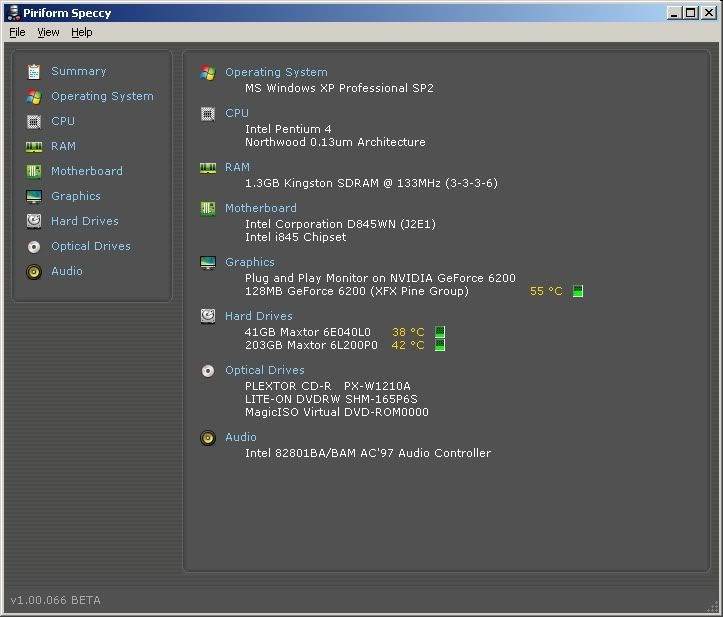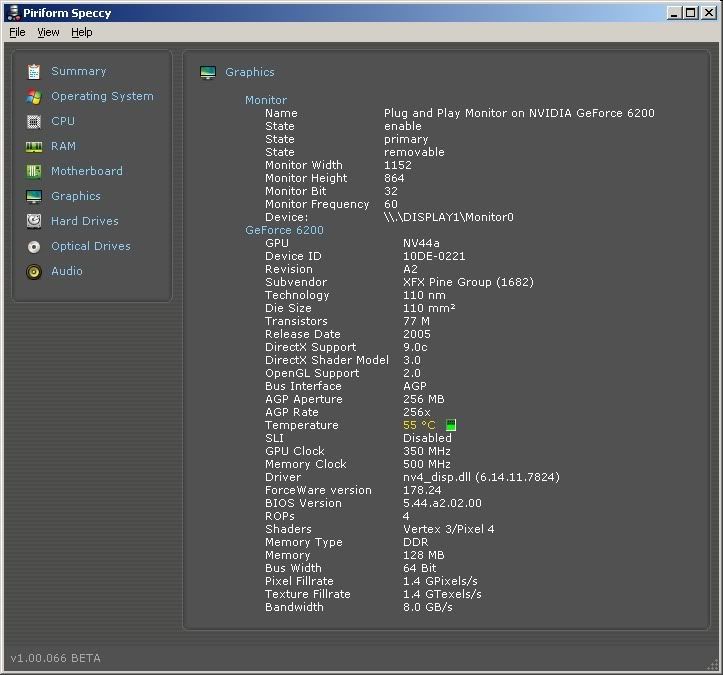-
Posts
1,200 -
Joined
-
Last visited
Posts posted by redhawk
-
-
interrupting defraggler will not cause any problems because only when a file has be relocated will this information be written to the hard drive else it be discarded.
Richard S.
-
How about posted links or signatures requiring human approval first I wish web wiz did something like that.
Richard S.
-
It's the storage file used when your machine goes into hibernation.
I don't know why it's not defragging maybe you don't have enough contiguous free space for it to be moved.
If you have no need for hibernation you could always turn this feature off and free up more hard drive space.
Richard S.
-
I agree I see no technical reason why the handle cannot be purged if the drive is not being processed I guess this problem was overlooked by the coders.
Richard S.
-
Defraggler seems to have a permanent handle open for every available drive in Windows not just the flash drive.
Without the flash drive handle close it cannot be safely removed however you can force close a process handle with software.
I would have recommended Unlocker however I understand it does not support Vista 64 therefore I would suggest using Sysinternals Process Explorer instead - http://technet.microsoft.com/en-gb/sysinte...s/bb896653.aspx
Richard S.
-
1.With addition of new hard drive do I need to reformat my existing drives to be more efficient ?
No, you have an external hard drive this will not influence the performance of the internal hard drive containing the Operating System you will however may find that the external drive is slower because USB is slower than IDE/SATA.
2.Backed up programs on existing D drive-is it better to put all of these on the new (G) drive ? (if so do I need to do anything with the programs so they know to go to the new G drive and not the old D driveUnless you have the original install files backing up programs is a waste of time many are dependant on register entries and library files that you simply cannot just copy files.
Personally I would take your 500GB hard drive and partition it into 50/50 or 250GB/250GB or split into another ratio you see fit.
Next I would use backup software and make a clone copy of your Operating System and save this to the first partition of your external drive.
Now you have a clone of you Operating System when something bad happens you have a reliable means of restoring everything as it was with all programs and files intact.
For the 2nd partition of your external drive you could store all your photos, music, video files etc stuff accumulated since your last back up.
As for Malware threats I wouldn't worry too much most only usually infect the Operating System hard drive I've rarely seen any infect other drives.
If you’re still bothered about this problem then install a good Anti-Virus program and make sure Windows has all the latest service packs and patches installed.
Also I would avoid using Internet Explorer although this is purely a personal choice of mine.
IE bug's tend to get exploited a lot that I personally never feel safe using it, and for the years I've ran Firefox I've never encountered a single Malware problem on my machine.
Richard S.
-
34.0

Richard S.
-
Just because you've defragged your drive doesn't mean a file won't fragment later, what is more important is the number of fragments not the file size.
If your file in question was contiguous but after it there was no room to expand i.e. another file exists after it then Windows would have to write the additional data elsewhere causing fragmentation.
Whether you defrag this file again is your choice however personally I would be happy to leave files over 1GB with up to 4 fragments.
Richard S.
-
"clean" destroys the partition table unfortunately this process is irreversible with any diskpart command I know of.
I made the same mistake once with a VM image but couldn't find a single tool (even Hirens tools) to restore the deleted partition.
Luckily I had a backup copy so I had only lost a few installed programs I was testing at the time.
As far as can tell "clean" only overwrites the first few sectors so theoretically you should be able to recover most of your files using recovery software.
Have you tried Recuva "Deep Scan" by any chance??
Richard S.
-
The only thing I will say about Linux is don't trust the NTFS support for modifying or creating files it has been reserve engineered due to lack of documentation and is generally considered use at your own risk.
There are alternatives though such as ERD Commander and BartPE which are both bootable Windows OS on CD providing networking, Flash drive support and because it's Windows accessing an NTFS drive is 100% safe.
I've used BartPE many times to fix damaged file systems and machines with virus infections it really is a very useful tool.
BartPE also has a range of plugins to enable tools such as AV tools to work correctly so you're never short of things to run.
In the past year I've found some interesting unofficial BartPE builds such as "super winpe plus" and "HirensTools v10 (Mini Windows XP)" all packed with useful software however sadly some being unlicensed versions.
Richard S.
-
I never understood the drive behind the ReactOS project considering most computers come preinstalled with Windows anyway - why reinvent the wheel??.
I've used it under emulation and I have to say I'm not all that impressed I get more stability out of Windows 3.11 than ReactOS - http://i53.photobucket.com/albums/g79/redh...iform_win31.jpg

btw: http://toastytech.com/guis/ is a highly recommended site if you want to learn about other Operating Systems past and present.
Richard S.
-
When you say crash, do you have any information as to the error message or when it happens.
What version of Windows and service pack do you have installed??
Richard S.
-
Are you running any security software it sounds like Recuva is being prevented from performing it's low level scanning.
Richard S.
-
Defraggler uses the Windows API (application programming interface) to perform the defragging therefore it's 100% safe to use.
In the event of a crash when a file is being moved the changes are not committed to the file system because it was interrupted therefore remains unchanged.
Richard S.
-
Is there any point defragging files "C:\System Volume Information" they're only used by the Operating System if a System Restore is performed and would have no real impact on current performance.
As for the folder being accessible in XP but not Vista or Windows 7 this isn't strictly true XP can still lock the folder it depends on a few conditions.
If XP is install on a FAT32 partition then "C:\System Volume Information" is accessible however under NTFS security permissions prevent unauthorised access even if you're using an administrator account.
To get around this block you need to edit the security permissions for "C:\System Volume Information" and add Administrator will full access.
I'm not sure about Vista or Windows 7 but I would assume you can also tweak security permissions to gain access too pretty much like XP.
Richard S.
-
The idea of defragging freespace is you move all the files scattered on the hard drive to the start of the disk thus creating move contiguous free space.
While this sounds like a great idea in practice it can leave empty gaps inside the compact area of files on your hard drive because the moved files are too big to fit the gaps.
This is why you have "Allow Fragmentation" basically you can fill the empty gaps at the cost of re-fragmenting the files again.
Richard S.
-
I suspect there's very little between them I think with "Quick Defrag" you can define a set of rules and simply one-click defrag your files without bothering to check the file list.
Richard S.
-
There is one other option to try: "Last Known Good Configuration" if that fails please use the "disable automatic restart...." and post the STOP code.
Richard S.
-


Richard S.
-
Recuva is a recovery utility for deleted files it will not help you copy files from a dead Operating System.
From your description it sounds like you're experiencing a reboot from a blue screen of death, without the STOP code it would be difficult to resolve the problem.
However you could try the following:
Hit F8 before the Windows splash screen appears and you should have some options:
try "Safe Mode" to start with and see if you laptop will eventually get to the desktop
If it reboots then repeat the F8 procedure again and select the option "disable automatic restart..." and post the STOP code here.
If you're considering to backup you files I would recommend BartPE (needs an XP install CD) or Hiren's Tools which both contain a bootable Windows environment on a CD with support for USB flash drives (you must insert the flash drive during the XP splash screen not after).
Richard S.
-
When it comes to defragging system files I like to use a boot CD of BartPE to perform this task because some files are just not accessible from inside Windows XP.
Defraggler runs nicely under BartPE however it totally ignores c:\pagefile.sys when attempting to defrag.
I find this a little odd since it was able to provide me with fragmentation info therefore it should know the file isn't locked.
Would it be possible to provide a future version of Defraggler without restrictions to processing c:\pagefile.sys??
Edit: I've successfully patched out pagefile.sys from the executable and it worked, so I personally think this limitation is unnecessary.
Richard S.
-
I have an Intel 845 chipset motherboard and an NVIDIA 6200 AGP card.
It claims my AGP rate is 256x which is wrong, my motherboard supports up to 4x but the NVIDIA 6200 is capable of 8x
Richard S.
-
I've been using version v.133.451 and would like to make the following suggestions.
- Filters to exclude/include files that are unrecoverable or slightly damaged (depending on the user's choice).
- When using "Tree View" unrecoverable / slightly damaged files should be a different colour i.e. red / blue / green this would make identification of status quicker without having to hover the mouse over the filenames.
- Filename filter box should wait a few seconds until the user has stopped typing instead of adjusting the result with every keystroke.
Currently typing inside the filter box makes the program run incredibly sluggish if the recovery list is large.
- Previews of image files should check for valid headers before rendering and perhaps should not claim "Excellent" status if invalid.
Maybe it does check?? however something happened to Recuva when I previewed an "excellent" corrupted .jpg file one of the program threads was consuming 90% of the CPU load doing nothing.
(edit: I've tested it again and unable to reproduce the CPU consuming thread however I'll post the stack if it does)
- Renaming deleted files after using Secure Overwrite, since the contents can be removed and destroyed I see no reason why the filename cannot be changed also.
cheers,
Richard S.



Seggestion - Defraggler Live CD
in Defraggler Suggestions
Posted
Defraggler runs nicely under BartPE to include this on a live CD use a ISO editor and add your own software folder.
It should be noted defraggler is coded not to process pagefile.sys which seems rather odd since it's not locked in this environment.
You can however remove this restriction by locating the unicode string pagefile.sys inside the executable and patch it.
Richard S.